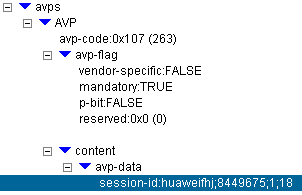Session-Id AVP
Description of AVP
AVP |
Description |
|---|---|
Session-Id |
The Session-Id AVP (AVP Code 263) is of type UTF8String and the maximum length is 139 bytes. It is used to identify a specific session. All messages pertaining to a specific session must include only one Session-Id AVP and the same value must be used throughout the life of a session. When present, the Session-Id should appear immediately following the Diameter Header. The Session-Id
must be globally and eternally unique, as it is meant to uniquely
identify a user session without reference to any other information,
and may be needed to correlate historical authentication information
with accounting information. The Session-Id includes a mandatory portion
and an implementation-defined portion; a recommended format for the
implementation-defined portion is outlined below.
The Session-Id AVP is created by the Diameter application initiating the session, which in most cases is done by the client. Note that a Session-Id may be used for both the authorization and accounting commands of a given application. NOTE:
The Session-Id AVP has a maximum of 127 bytes. This AVP is generated by the PCEF and must be unique on the entire network to avoid misoperation when resources are inconsistent. On an NetEngine 8000 F, the format is:
|
Reference Standards
RFC 3588 clause 8.8
